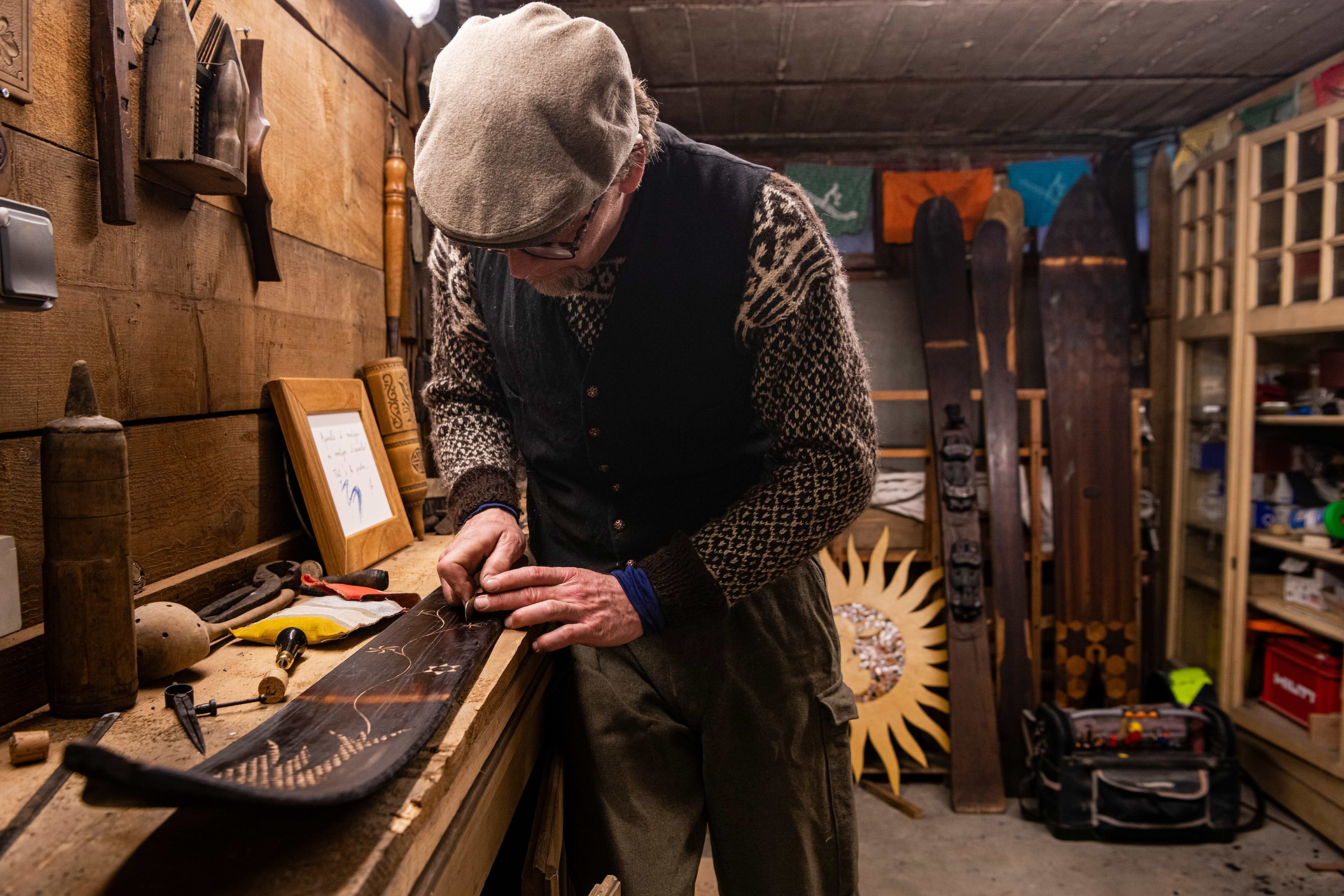

Peter Steltzner looks like he’s stepped out of a vintage postcard of nineteenth-century pioneering mountaineers. Wearing woolen knicker boxers, a Norwegian wool cardigan, donning a classic cap, and carrying an old pack, this American artisan ski maker skillfully navigates untouched powder in Chamonix La Flégère with both precision and style. Between his telemark turns, Steltzner enthusiastically talks about wood cores, turn radius, stiffness, and snow connection, both on and off the slope.
Steltzner stands out in our rapidly evolving, high-tech consumer world, but despite his traditional appearance, he is among the most knowledgeable experts in modern ski design and shaping. Specializing in aesthetic, handcrafted wooden skis for the modern freeskier, Steltzner's skis strike a remarkable balance between beauty and performance, fine art and precision tools. He aims to craft the ultimate ski for everyone, suitable for any condition, guided by the harmony of tradition and performance while maintaining passion and soul in each piece. Every pair of skis he crafts is unique.



After living in Paris for 20 years and making a living crafting handmade wooden furniture, the soft-spoken American from Sausalito, California, found his true calling in the Chamonix Valley. Following his passion for the mountains and skiing, Steltzner seized the opportunity to rent a historic old water mill in Les Praz, a picturesque village on the outskirts of Chamonix. There, he created his first Rabbit on the Roof skis, a name that pays homage to the colony of rabbits that lived on the roof of his Paris workshop.
Stelzner’s face lights up when he talks about the mill. It’s a part of him, and he’s a part of it. When Steltzner and his wife, Anati Graetz, moved in, it became "Le Moulin des Artistes" (the artists' mill) and served as a rare sanctuary for artists in the Chamonix valley. They hosted exhibitions, parties, and open houses. Above all, Peter had a workshop to craft wooden skis.
The core material is always sustainably sourced European Ash, known for its natural suppleness and flexibility, with a distinctive density that effectively absorbs vibrations. The skis are finished with different wood types tailored to the specific ski and its owner, including beech, bamboo, chestnut, cherry, rosewood, and others.



“It's like choosing a color palette,” Steltzner explains. “After years of work as an ébéniste (master craftsman) in Paris, I've learned why to choose a particular wood, how I need to relate to it, how to see it, what part I should use, and what works best for a ski. Each piece of wood has a history to it.”
The most vital part of his craft is the personal connection with the skier who will use the ski. Every build involves analyzing the individual’s stature, their skiing style, and their preferences. Ultimately, the ski and the skier develop a lasting relationship and evolve together. Steltzner maintains personal contact with every user of his skis.
“People get attached to their skis,” Steltzner says. “It's like a musician with his instrument; it becomes an extension of your body. It's always such a pleasure when people come back and tell you how much they love their skis. Most clients are passionate skiers; they’ve been through industrial pairs, and they want to find their perfect skis. They like the concept of a beautiful object that also is technically performant.”



The iconic mill caught fire on a December night in 2016. Peter Steltzner's life's work was burned along with the flames that night. The couple's private home, their workshop, the machines, an irreplaceable collection of unique wood, the annual production of skis awaiting delivery, Anati's paintings, hand-crafted furniture, and a collection of artwork by artist and mountain guide Andy Parkin—all were reduced to ashes.
There was nothing the couple could do. They stood in shock all night, watching their entire life go up in flames.
The Chamonix Valley stood in solidarity after the fire. Everyone in the community wanted to help the couple and their business recover. However, the process has been emotionally taxing and filled with moments of despair.

Gracious powder skiing by Steltzner with the Mont Blanc massif in the background and a mountain goat checking out Peters style.

A Rabbit on the Roof skis are handmade by Steltzner in his Chamonix workshop. Genuine artwork by a real craftsman.
After years of work as an ébéniste (master craftsman) in Paris, Steltzner has learned why to choose a particular wood, how he needs to relate to it, how to see it, what part he should use, and what works best for a ski.
“Skiing has helped me enormously to heal. It's a personal moment of pleasure when you leave all your worries behind.”
Peter Steltzner
After years of hardship, Steltzner finally secured the funding and resources to rebuild his cherished workshop and the couple’s home, aiming to restore the mill from the ashes. With community support in sourcing used machinery and equipment, the workshop has been successfully reassembled. The press needed a complete restoration. Months after the fire, when Steltzner finally got the press working again, a pair of rare skis inside remained untouched by the flames. These skis will serve as a personal keepsake, symbolizing the revival of Rabbit on the Roof skis.

JOSEFINE ÅS is a Swedish freelance journalist and PR manager living in the southern French Alps. Off-piste skiing and ski touring off the beaten path is a lifelong passion and a big part of her daily winter life. She enjoys exploring her new hoods around Serre Chevalier and her old hoods in La Grave, just a few kilometers away.
RELATED STORIES